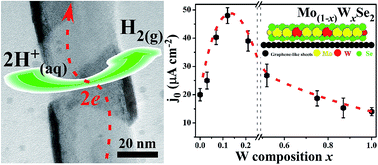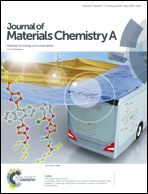Engineering sub-100 nm Mo(1−x)WxSe2 crystals for efficient hydrogen evolution catalysis†
Abstract
The edge site of two-dimensional (2D) transition metal dichalcogenides (TMDs) is active towards the hydrogen evolution reaction (HER). Herein, a feasible synthesis of sub-100 nm molybdenum/tungsten diselenide [Mo(1−x)WxSe2] crystals is described. The abundant edge exposure and heteroatom-doping synergistically boost the catalysis of HER by this material. In this work, sub-100 nm Mo(1−x)WxSe2 single crystals were grown on a nitrogen-doped multiwall carbon nanotube before being applied as HER electrocatalysts. At x = 0.13 ± 0.02, the Mo(1−x)WxSe2 shows optimal HER catalytic performance with low overpotentials (70 and 129 mV) required to achieve current densities of −1 and −10 mA cm−2, respectively, along with a Tafel slope of 53.6 mV dec−1 and an exchange current density of 49.5 μA cm−2. Density functional theory (DFT) calculations indicate that the Gibbs free energy of the HER process at the edge site of the crystals reaches a minimum value of 0.06 eV, which is lower than when the reaction is catalysed on Pt active sites. This study provides a general approach to increasing the edge proportion of the catalyst material and activating the terrace of the 2D materials for catalysis, which may be of benefit to the design and fabrication of other TMDs-based compounds.



 Please wait while we load your content...
Please wait while we load your content...